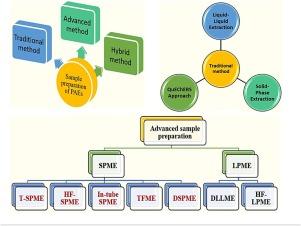Comprehensive review of sample preparation strategies for phthalate ester analysis in various real samples
IF 4.9
2区 化学
Q1 CHEMISTRY, ANALYTICAL
引用次数: 0
Abstract
Phthalate esters (PAEs), ubiquitous plasticizers in diverse consumer products, pose significant environmental and human health risks due to their persistence and endocrine-disrupting properties. Accurately determining PAEs in various environmental matrices is crucial for evaluating exposure levels, assessing risks, and implementing effective mitigation strategies. This review comprehensively examines sample preparation techniques for PAE analysis, focusing on methodologies. We categorize these techniques into traditional methods (solid phase extraction, liquid–liquid extraction, QuEChERS), advanced techniques (liquid phase microextraction, solid phase microextraction, and their modifications), and hybrid approaches combining multiple techniques. The strengths, limitations, and recent advancements of each method are thoroughly discussed. This compilation not only summarizes current knowledge but also highlights emerging trends and research gaps, providing valuable insights for future investigations. By fostering scientific progress and innovation in PAE analysis, we aim to support the development of robust analytical methods that contribute to environmental monitoring and risk assessment, ultimately safeguarding human health and the environment.

全面回顾用于分析各种实际样品中邻苯二甲酸酯的样品制备策略
邻苯二甲酸酯(PAEs)是各种消费品中无处不在的增塑剂,由于其持久性和干扰内分泌的特性,对环境和人类健康构成了重大风险。准确测定各种环境基质中的 PAEs 对于评估暴露水平、评估风险和实施有效的缓解策略至关重要。本综述全面探讨了 PAE 分析的样品制备技术,重点是方法学。我们将这些技术分为传统方法(固相萃取、液液萃取、QuEChERS)、先进技术(液相微萃取、固相微萃取及其改进)以及多种技术相结合的混合方法。每种方法的优势、局限性和最新进展都有详尽的讨论。这本汇编不仅总结了当前的知识,还强调了新出现的趋势和研究空白,为未来的研究提供了宝贵的见解。通过促进 PAE 分析领域的科学进步和创新,我们旨在支持开发有助于环境监测和风险评估的可靠分析方法,最终保护人类健康和环境。
本文章由计算机程序翻译,如有差异,请以英文原文为准。
求助全文
约1分钟内获得全文
求助全文
来源期刊

Microchemical Journal
化学-分析化学
CiteScore
8.70
自引率
8.30%
发文量
1131
审稿时长
1.9 months
期刊介绍:
The Microchemical Journal is a peer reviewed journal devoted to all aspects and phases of analytical chemistry and chemical analysis. The Microchemical Journal publishes articles which are at the forefront of modern analytical chemistry and cover innovations in the techniques to the finest possible limits. This includes fundamental aspects, instrumentation, new developments, innovative and novel methods and applications including environmental and clinical field.
Traditional classical analytical methods such as spectrophotometry and titrimetry as well as established instrumentation methods such as flame and graphite furnace atomic absorption spectrometry, gas chromatography, and modified glassy or carbon electrode electrochemical methods will be considered, provided they show significant improvements and novelty compared to the established methods.
 求助内容:
求助内容: 应助结果提醒方式:
应助结果提醒方式:


